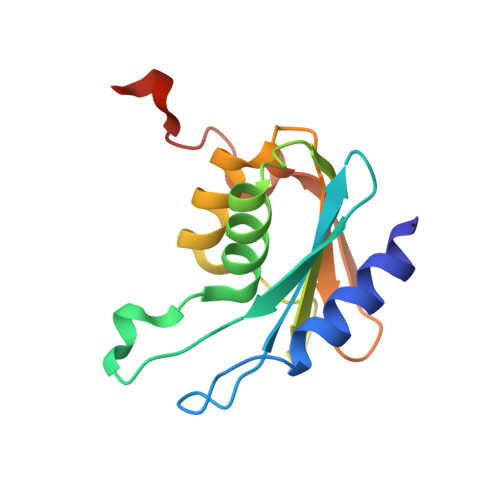Structural, Kinetic, and Mutational Studies of the Zinc Ion Environment in Tetrameric Cytidine Deaminase
Johansson, E., Neuhard, J., Willemoes, M., Larsen, S.(2004) Biochemistry 43: 6020
- PubMed: 15147186
- DOI: https://doi.org/10.1021/bi035893x
- Primary Citation of Related Structures:
1UWZ, 1UX0, 1UX1 - PubMed Abstract:
The zinc-containing cytidine deaminase (CDA, EC 3.5.4.5) is a pyrimidine salvage enzyme catalyzing the hydrolytic deamination of cytidine and 2'-deoxycytidine forming uridine and 2'-deoxyuridine, respectively. Homodimeric CDA (D-CDA) and homotetrameric CDA (T-CDA) both contain one zinc ion per subunit coordinated to the catalytic water molecule. The zinc ligands in D-CDA are one histidine and two cysteine residues, whereas in T-CDA zinc is coordinated to three cysteines. Two of the zinc coordinating cysteines in T-CDA form hydrogen bonds to the conserved residue Arg56, and this residue together with the dipole moments from two alpha-helices partially neutralizes the additional negative charge in the active site, leading to a catalytic activity similar to D-CDA. Arg56 has been substituted by a glutamine (R56Q), the corresponding residue in D-CDA, an alanine (R56A), and an aspartate (R56D). Moreover, one of the zinc-liganding cysteines has been substituted by histidine to mimic D-CDA, alone (C53H) and in combination with R56Q (C53H/R56Q). R56A, R56Q, and C53H/R56Q contain the same amount of zinc as the wild-type enzyme. The zinc-binding capacity of R56D is reduced. Only R56A, R56Q, and C53H/R56Q yielded measurable CDA activity, R56A and R56Q with similar K(m) but decreased V(max) values compared to wild-type enzyme. Because of dissociation into its inactive subunits, it was impossible to determine the kinetic parameters for C53H/R56Q. R56A and C53H/R56Q display increased apparent pK(a) values compared to the wild-type enzyme and R56Q. On the basis of the structures of R56A, R56Q, and C53H/R56Q an explanation is provided of kinetic results and the apparent instability of C53H/R56Q.
Organizational Affiliation:
Centre for Crystallographic Studies, Department of Chemistry, University of Copenhagen, Universitetsparken 5, DK-2100 Copenhagen Ø, Denmark. [email protected]
















